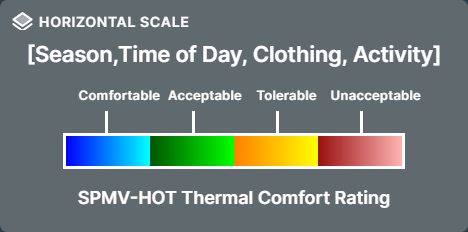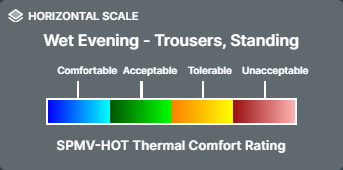Below is a description of how to interpret the Thermal Comfort – SPMV HOT (Hot and Tropical Climates) Color Legend that is visible in the viewer. Understanding these legends will help make the most out of analyzing your results.

SPMV*
In an outdoor environment, the “Standard Predicted Mean Vote Modified” (SPMV*) metric is used as it can effectively account for the physics associated with elevated solar exposure and humidity ranges present outdoors. SPMV* is a modified version of the ASHRAE PMV metric which better accounts for the larger range of outdoor conditions.
Thermal comfort is a useful concept and SPMV* provides a method to communicate this concept. Still, it should be noted that the SPMV* index is based on surveys and perceptions of individuals. It is based on 80% of respondents agreeing on the condition they are feeling. It is, in no way, a definitive measure of an individual’s thermal comfort. Also, the variety of conditions and activities that impact the perception of comfort are large and varied.
Any thermal comfort analysis should therefore be viewed as a guide and not as a quantitative assessment.
What is it measuring?
Thermal Comfort scale for a given season (range of months), time of day period (range of hours), clothing and activity level. Thermal comfort is finding a perfect balance when people in outdoor spaces aren’t too cold, too warm, and when it’s neither too sunny, too cold, nor too windy for pedestrians.
What does the scale mean?
This is a SPMV* for hot and tropical climates. The color scale shows what the average thermal comfort conditions are at a location.
The color scale indicates four types of zone:
- Comfortable: this location is similar to indoors. No thermal stress.
- Acceptable: A person will generally accept this location as comfortable since they are outdoors. Some thermal stress.
- Tolerable: A person will stay at this location for some time but will seek better conditions.
- Unacceptable: Too hot. A person will seek cooler conditions.
What options can I specify?
The Season, Time of Day, Clothing Type and Activity Type is defined by the user (or predefined for them). Example:
